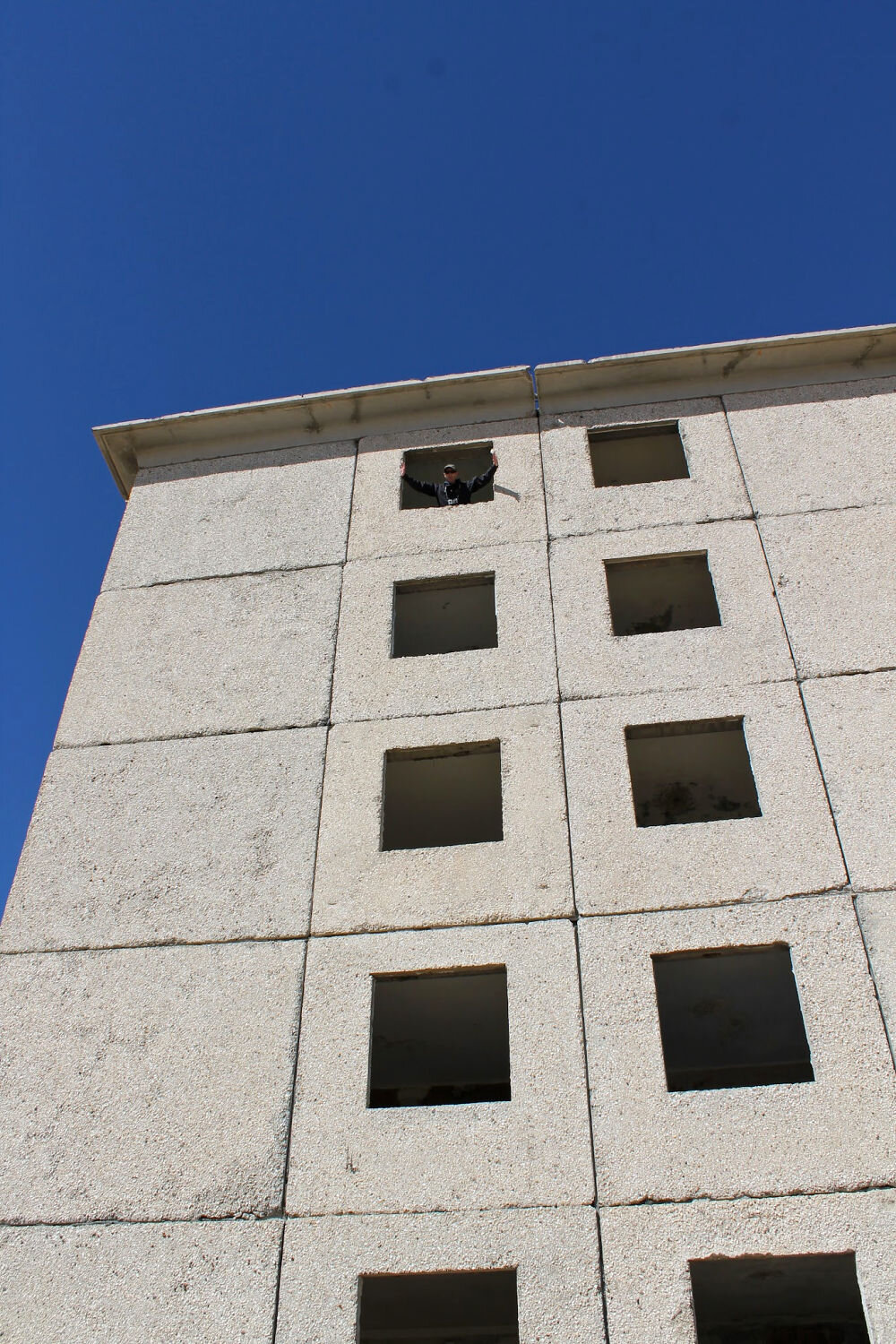Exploring an Abandoned Soviet Airbase in Mongolia
Where- Bayantal Airbase, Choir, Mongolia
When- September 2013
*This post contains affiliate links to products I recommend. If you make a purchase through these links I will receive a small commission at no cost to you.
Stark crumbling buildings stood out in the flat desert landscape. An overgrown runway and bunkers disappeared into the sand as the dust storms and desert slowly took back Bayantal Airbase.
Once a Soviet-run outpost, Bayantal Airbase operated between the 1970s and the 1990s as part of the 126th Fighter Aviation Regiment. Abandoned for decades, with the exceptions of a few locals, the base was positioned by the Soviet Union as a frontline against potential invasion from China.
The airbase now consists of an old runway, aircraft hangars, bunkers, a few buildings and an empty shell of apartment buildings with caved in entrances. There is also an old Mig-21 fighter-jet you can climb up to.
Exploring the Bayantal Airbase
We arrived in two four-wheel drives; a group of friends getting away from Ulaanbaatar for a weekend of camping and exploring. It was Saturday morning and the drive from UB had been about four hours heading South, on and off-road. This was back in 2013. The roads into the Gobi Desert were much rougher than they are today. In 2020, the drive might take you two and a half hours.
We drove across the rough dirt road, passed a collapsing fence and found ourselves in a sea of rubble and broken bits of old metal. The entrance to the base was a crumbling concrete archway with bits of metal sticking out and a sad-looking Air Force insignia at the top. We had arrived.
There wasn’t much to see. We drove as close as we could to the runway and stopped next to a dilapidated brick building with rusted steel doors. Not far away we could see where the runway should be, bordered by mounds of bunkers pushing their way out of the earth.
As I stepped out of the 4WD, the smell of wild herbs drifted up from the ground. You may think of a desert as just being sand, but the Gobi is rich in plants and wildlife. Small grasses and wild herbs link in a carpet over the earth. Every time you step on them and crush them, all the beautiful smells rise around you, mixing with the dry dusty smell of the desert.
We all stretched and admired the clear blue sky, Mongolia living up to it’s name as the Land of Eternal Blue Sky. We were happy to be out of the vehicles, but there wasn’t much to see. In the distance were the old apartment blocks. In the other direction there was an old house or office with several Mongolian gers (traditional felt tents) set up outside, indicating that someone was living there. In our immediate area there were rough piles of dirt, lots of rubble and old bricks, random bits of iron, some old barrels, old pipes and various bits of wire sticking up and strewn around.
As we were about to walk toward the bunkers, the sound of motorbikes drew near. Two guys on bikes arrived, one had a little girl on the back. Their message was clear, they didn’t want us there. It was also clear that they weren’t going to leave until we did. We looked towards the bunkers and aircraft hangars. They were so close, but there was no way we were going to get a look.
There were no ‘no-entry’ signs or gates stopping people from entering. But these guys seemed to be guards. One guy was wearing army boots, army-green pants and hat, but in Mongolia this doesn’t mean much. All security guards wear military-style uniforms, whether it is for shopping centres, apartments, car parks or markets, everyone has to have their camo. The other guy was wearing a traditional Mongolian Deel, a practical outfit commonly worn by people in the countryside.
We didn’t get the chance to explore the bunkers. Instead we got back in the vehicles and headed for the apartment blocks not too far away.
Abandoned apartments
The apartments looked like giant concrete blocks of Lego all stacked on top of each other. The enormous shells of buildings loomed over us. It was a cool, crisp and sunny morning, but wandering outside the apartments left an uneasy prickling across the back of my neck. It was too quiet.
There were two rows of buildings with three blocks of apartments on each side and a wide open space between. Old concrete borders and broken slabs of concrete outlined where paths or roads once were. On one side, it looked like people might live in the apartments way down the end. There were a few gers set up between the rows.
We tried to find a way into the building but saw that all the entrances were blocked off. Each numbered doorway either had a slab of concrete blocking the entrance, or they had purposefully collapsed the stairwell inside to prevent anyone from entering.
Soon enough we found an entrance where the collapsed stairs had enough rubble that we could climb up to the first floor. Some sheep must have found their way in at some point; we came across several dead ones that never found their way out.
It was much colder inside the building. Our voices echoed in the empty corridors, the eeriness made it feel wrong to speak above a whisper. We explored forgotten rooms and empty hallways. In some places the floors and stairs had collapsed and we had to jump over holes, or weave our way carefully up the steps. At some point people must have been squatting in some of the rooms, we found remnants of old fires, animals bones and lots of rubbish. At the bottom of some stairwells were more piles of rubbish and bones.
Many of the rooms were sparse with bland concrete walls, the floors littered with dust and rubble. I found several holes in walls where birds had made cosy little homes. Some of the rooms had layers of peeling wallpaper, with some walls revealing four layers of overlapping different patterns. It made me wonder about the original families that had lived there, each covering up the last’s choice in wallpaper. I wonder what their lives were like?
Some rooms were plastered with old Soviet newspapers, mostly pasted upside down but still clear enough to read. One had an article dated 9th March 1971.
In one room we found a print on the wall of Leonardo da Vinci’s Madonna and Child. This room caused a prickling feeling on the back of my scalp. Like there might be some spirits following us around. At that point I was ready to get out.
We made our way back to the first floor. There were no doors in that part of the building that led outside, they were all blocked up. We went between rooms on the first floor until we found one with a window that was closest to the ground. Still one floor up, rather than try to find our way back to our original entrance on the other side, we decided to jump out the window closer to the car.
It wasn’t that high, but at the time to me it seemed pretty far from the ground! I lowered myself off the side of the concrete and dangled. I am not good with heights, even this low jump made my toes tingle. Anyway, I lowered myself down and easily dropped to the ground.
Our friend Dallas had navigated his way to the very top of the building somehow. I didn’t want to go any higher up, not trusting the collapsing staircases. We waved to Dallas as he shouted down from the top window. We enjoyed some hot drinks and ate our sandwiches. Our next stop was the plane that looked like a rocket, a few hundred meters away.
Mig-21
Coordinates- 46°33'36.8 "N 108°18'33.9 "E
We found ourselves in front of an old Mig-21 jet. It stood proudly on its concrete pedestal pointing toward the heavens but looking like it had seen better days. The Mig-21 was a Soviet designed supersonic jet-fighter and interceptor aircraft. A popular lightweight fighter, it could reach speeds of Mach 2 and was flown by over 60 countries from 1959 onward.
We went to get a closer look. The way they set it into the concrete was perfect for climbing up. It was a beautiful day and seemed like the perfect time to be standing on a random fighter plane monument in the middle of the Gobi Desert. What’s great about this, is you get a closeup look at a real piece of history without being in a museum.
Examining this random metal structure in the desert made me imagine what the base must have been like when it was active. What the two mile long runway might have looked like when it was new; planes buzzing around, troops training, rattling Soviet trucks bouncing around the desert (though these trucks are still a common sight today). I imagine it was much more lively than the quiet desert settlement today.
This trip really stuck with me, even years later when I’m writing about this is 2020. I look back on it as one of those experiences that was so interesting and like nothing else I’d seen. There are many strange adventures to be had in Mongolia, most of them you can never really plan for, or even know what to expect until you get there. My advice is to go there and make the most of it.
Pin it on pinterest
Disclaimer- We were there in 2013 and there were no signs saying you couldn’t go into the base. But there were people guarding it and we were asked to leave by guys on motorbikes not long after we started exploring the area with the bunkers. We were free to explore the abandoned apartment blocks. Explore at your own risk and check for up-to-date references before you go.
related Articles about mongolia
Book recommendations for Mongolia!
Leave a comment below- Have you ever been somewhere strange or creepy somewhere in the world? Tell me about it, I’d love to hear!















































